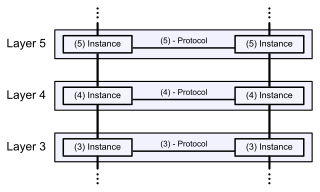
The Open Systems Interconnection model is a conceptual model from the International Organization for Standardization (ISO) that "provides a common basis for the coordination of standards development for the purpose of systems interconnection." In the OSI reference model, the communications between a computing system are split into seven different abstraction layers: Physical, Data Link, Network, Transport, Session, Presentation, and Application.
The Session Initiation Protocol (SIP) is a signaling protocol used for initiating, maintaining, and terminating communication sessions that include voice, video and messaging applications. SIP is used in Internet telephony, in private IP telephone systems, as well as mobile phone calling over LTE (VoLTE).

SOAP is a messaging protocol specification for exchanging structured information in the implementation of web services in computer networks. It uses XML Information Set for its message format, and relies on application layer protocols, most often Hypertext Transfer Protocol (HTTP), although some legacy systems communicate over Simple Mail Transfer Protocol (SMTP), for message negotiation and transmission.
A web service (WS) is either:
Universal Plug and Play (UPnP) is a set of networking protocols that permits networked devices, such as personal computers, printers, Internet gateways, Wi-Fi access points and mobile devices to seamlessly discover each other's presence on the network and establish functional network services. UPnP is intended primarily for residential networks without enterprise-class devices.
Zigbee is an IEEE 802.15.4-based specification for a suite of high-level communication protocols used to create personal area networks with small, low-power digital radios, such as for home automation, medical device data collection, and other low-power low-bandwidth needs, designed for small scale projects which need wireless connection. Hence, Zigbee is a low-power, low data rate, and close proximity wireless ad hoc network.
Web Services Security is an extension to SOAP to apply security to Web services. It is a member of the Web service specifications and was published by OASIS.
Web Services Discovery provides access to software systems over the Internet using standard protocols. In the most basic scenario there is a Web Service Provider that publishes a service and a Web Service Consumer that uses this service. Web Service Discovery is the process of finding suitable web services for a given task.
In computing, Web-Based Enterprise Management (WBEM) comprises a set of systems-management technologies developed to unify the management of distributed computing environments. The WBEM initiative, initially sponsored in 1996 by BMC Software, Cisco Systems, Compaq Computer, Intel, and Microsoft, is now widely adopted. WBEM is based on Internet standards and Distributed Management Task Force (DMTF) open standards:
The Windows Communication Foundation (WCF), previously known as Indigo, is a free and open-source runtime and a set of APIs in the .NET Framework for building connected, service-oriented applications.
Layered Service Provider (LSP) is a deprecated feature of the Microsoft Windows Winsock 2 Service Provider Interface (SPI). A Layered Service Provider is a DLL that uses Winsock APIs to attempt to insert itself into the TCP/IP protocol stack. Once in the stack, a Layered Service Provider can intercept and modify inbound and outbound Internet traffic. It allows processing of all the TCP/IP traffic taking place between the Internet and the applications that are accessing the Internet (such as a web browser, the email client, etc.). For example, it could be used by malware to redirect web browers to rogue websites, or to block access to sites like Windows Update. Alternatively, a computer security program could scan network traffic for viruses or other threats. The Winsock Service Provider Interface (SPI) API provides a mechanism for layering providers on top of each other. Winsock LSPs are available for a range of useful purposes, including parental controls and Web content filtering. The parental controls web filter in Windows Vista is an LSP. The layering order of all providers is kept in the Winsock Catalog.
An XML appliance is a special-purpose network device used to secure, manage and mediate XML traffic. They are most popularly implemented in service-oriented architectures (SOA) to control XML-based web services traffic, and increasingly in cloud-oriented computing to help enterprises integrate on premises applications with off-premises cloud-hosted applications. XML appliances are also commonly referred to as SOA appliances, SOA gateways, XML gateways, and cloud brokers. Some have also been deployed for more specific applications like Message-oriented middleware. While the originators of the product category deployed exclusively as hardware, today most XML appliances are also available as software gateways and virtual appliances for environments like VMWare.

Apache Axis2 is a web service engine. It is a redesign and re-write of the widely used Apache Axis SOAP stack. Implementations of Axis2 are available in Java and C.
Windows Rally is a set of technologies from Microsoft intended to simplify the setup and maintenance of wired and wireless network-connected devices. They aim to increase reliability and security of connectivity for users who connect the devices to the Internet or to computers running Microsoft Windows. These technologies provide control of network quality of service (QoS) and diagnostics for data sharing, communications, and entertainment. Windows Rally technologies provide provisioning for the following devices:
The Microsoft Open Specification Promise is a promise by Microsoft, published in September 2006, to not assert its patents, in certain conditions, against implementations of a certain list of specifications.

The Web Services Description Language is an XML-based interface description language that is used for describing the functionality offered by a web service. The acronym is also used for any specific WSDL description of a web service, which provides a machine-readable description of how the service can be called, what parameters it expects, and what data structures it returns. Therefore, its purpose is roughly similar to that of a type signature in a programming language.
Cloud Infrastructure Management Interface (CIMI) is an open standard API specification for managing cloud infrastructure.
This page is based on this
Wikipedia article Text is available under the
CC BY-SA 4.0 license; additional terms may apply.
Images, videos and audio are available under their respective licenses.



